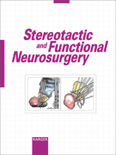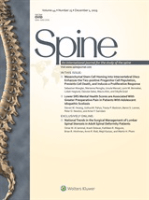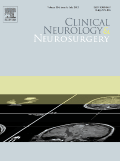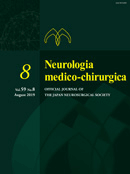
STEREOTACTIC AND FUNCTIONAL NEUROSURGERY
Scope & Guideline
Advancing the Frontiers of Neurosurgery
Introduction
Aims and Scopes
- Deep Brain Stimulation (DBS) Techniques:
The journal extensively covers research on various DBS methodologies, targeting specific brain regions to treat conditions like Parkinson's disease, epilepsy, and obsessive-compulsive disorder. - Radiosurgery Innovations:
Research on stereotactic radiosurgery techniques, including Gamma Knife and focused ultrasound, is a significant focus, exploring their applications in treating brain tumors and movement disorders. - Clinical Outcomes and Patient Safety:
Studies examining the efficacy and safety of neurosurgical interventions, including complications, infection management, and long-term outcomes for patients undergoing these procedures. - Neurophysiological Mechanisms:
Investigations into the neurophysiological changes and mechanisms underlying neuromodulation therapies, enhancing understanding of how these interventions affect brain function. - Ethical and Societal Implications:
The journal addresses the ethical concerns and societal implications associated with advanced neurosurgical interventions, particularly in vulnerable populations and for off-label uses.
Trending and Emerging
- Directional Deep Brain Stimulation:
Research on directional DBS is on the rise, focusing on its advantages in minimizing side effects and optimizing therapeutic outcomes for movement disorders. - Robotics in Neurosurgery:
The integration of robotic systems in stereotactic surgery is increasingly prevalent, with studies exploring their impact on surgical precision and efficiency. - Closed-Loop Systems:
Emerging interest in closed-loop DBS systems that adapt stimulation based on real-time feedback from the brain, promising to enhance treatment personalization and efficacy. - Focused Ultrasound Applications:
The application of focused ultrasound for non-invasive treatment of neurological conditions is trending, with growing research on its effectiveness and safety. - Patient-Centric Research:
There is a growing emphasis on patient-reported outcomes and quality of life assessments post-surgery, reflecting a shift towards more holistic approaches in treatment evaluation.
Declining or Waning
- Traditional Lesioning Techniques:
There appears to be a decline in the number of papers focused solely on traditional lesioning techniques, such as pallidotomy, as newer, less invasive methods gain traction. - Basic Neurosurgical Techniques:
Research centered on basic or foundational neurosurgical techniques has diminished, possibly overshadowed by the rapid advancements in more sophisticated technologies like robotic surgery. - Animal Models in Neurosurgery:
The use of animal models for studying neurosurgical techniques and outcomes is less frequently reported, as the field shifts towards clinical studies and human trials. - Static Imaging Techniques:
There is a noticeable reduction in studies utilizing static imaging modalities for stereotactic planning, with a growing emphasis on dynamic imaging technologies like MRI-guided approaches.
Similar Journals

Brain Hemorrhages
Fostering interdisciplinary research to enhance clinical care.Brain Hemorrhages is a pioneering open-access journal published by KEAI PUBLISHING LTD, dedicated to advancing the field of neurology with a specific focus on brain hemorrhages and their clinical implications. Established in 2020, this journal has quickly gained recognition, achieving a 2023 Q3 category ranking in both neurology and clinical neurology, as well as a Q2 ranking in surgery. With an e-ISSN of 2589-238X, it facilitates broad accessibility, allowing researchers and healthcare professionals worldwide to share and access vital findings without barriers. As it converges its publishing efforts toward 2024, Brain Hemorrhages aims to foster interdisciplinary research and clinical insights that can significantly influence treatment outcomes and enhance patient care. The journal stands as a critical resource for those exploring the complexities of brain hemorrhages, making it an essential addition to any academic or professional library within the fields of neurology and surgery.

NEUROLOGY INDIA
Fostering Global Dialogue in Neurological ScienceNEUROLOGY INDIA, a reputable journal published by Wolters Kluwer Medknow Publications, serves as a pivotal resource in the field of neurology, focusing on clinical and research insights from India and beyond. Established in 1965, this journal has embraced a rich publishing history, converging its years of publication with the intention of fostering knowledge exchange among healthcare professionals, researchers, and students. With an ISSN of 0028-3886 and E-ISSN 1998-4022, it is indexed and ranked in Quartile 3 for both Neurology and Clinical Neurology categories as of 2023. While it does not operate as an open-access journal, it remains an essential platform for disseminating high-quality research, contributing significantly to the understanding of neurological diseases and treatment options. Operating out of Mumbai, India, NEUROLOGY INDIA is committed to bridging the gap in global neurology discourse, and it stands as an important reference for practitioners and scholars seeking to advance their expertise in this critical area of medicine.

SPINE
Advancing knowledge in spine health since 1976.SPINE, published by Lippincott Williams & Wilkins, is a leading academic journal in the fields of Orthopedics, Neurology, and Sports Medicine. Established in 1976, this reputable journal has made significant contributions to advancing clinical and scientific knowledge, with its impactful research evidenced by its prestigious Q1 classification across three essential categories in 2023 and a notable ranking of #51 in Orthopedics and Sports Medicine and #117 in Clinical Neurology as per Scopus. SPINE aims to disseminate high-quality research articles, reviews, and clinical studies that address cutting-edge topics and challenges in spine-related health, thereby serving as an invaluable resource for researchers, healthcare professionals, and students alike. With its commitment to rigorous peer review and a wide readership, SPINE continues to be at the forefront of innovations in spine health & disease from 1976 to 2024, upholding its reputation as a catalyst for progress in the medical community.

CLINICAL NEUROLOGY AND NEUROSURGERY
Exploring Breakthroughs in Neurology and NeurosurgeryCLINICAL NEUROLOGY AND NEUROSURGERY, published by Elsevier, is a pivotal journal in the fields of neurology and neurosurgery, recognized for its rigorous peer-review process and commitment to advancing clinical practices. Established in 1974, the journal has become a respected source of innovative research, evidenced by its excellent Scopus rankings—placing it within the top half of journals in both Medicine (Surgery) and the clinical aspect of Neurology. Notably, it has achieved a Q2 ranking in both Medicine (miscellaneous) and Surgery, and Q3 in Neurology (clinical) as of 2023. The journal publishes a wide array of articles focused on the latest findings, clinical practices, and technological advancements that address neurological disorders and surgical interventions. While it does not currently operate under an open-access model, it remains highly accessible to academic institutions and professionals worldwide from its editorial base in the Netherlands. By enabling knowledge-sharing and fostering collaboration among researchers, practitioners, and students, CLINICAL NEUROLOGY AND NEUROSURGERY plays a crucial role in shaping the future of clinical neurology and surgical techniques.

JOURNAL OF NEUROLOGY NEUROSURGERY AND PSYCHIATRY
Connecting theory and practice in the realms of brain and mind.JOURNAL OF NEUROLOGY NEUROSURGERY AND PSYCHIATRY, published by the esteemed BMJ PUBLISHING GROUP, is a leading journal that covers pivotal research in the fields of neurology, neurosurgery, and psychiatry. With an impressive impact factor and consistently recognized as a Q1 journal in its respective categories—including Clinical Neurology, Psychiatry and Mental Health, and Surgery—this publication ranks in the top percentiles on Scopus, showcasing its influence in the medical community. Since its inception in 1920, the journal has been committed to delivering high-quality, peer-reviewed content to researchers, clinicians, and students alike, maintaining an exceptional reputation attributed to its rigorous selection process and the depth of its contributions. Access to the journal's articles fosters a comprehensive understanding of progressive research and clinical practices, solidifying its significance for professionals aiming to navigate the complexities of neurological and psychiatric disorders. As a vital resource based in the United Kingdom, the journal continues to propel innovation and knowledge sharing in the ever-evolving landscape of neurohealth.

NEUROLOGIA MEDICO-CHIRURGICA
Exploring the Frontiers of Neurological SurgeryNEUROLOGIA MEDICO-CHIRURGICA, published by the JAPAN NEUROSURGICAL SOCIETY, stands as a vital resource in the fields of neurology and surgery, featuring an impressive track record since its inception in 1959. With both an ISSN 0470-8105 and E-ISSN 1349-8029, this journal has embraced an Open Access model since 2000, ensuring that cutting-edge research and clinical advances are readily accessible to a global audience. The journal is currently ranked in the Q2 quartile for Neurology (clinical) and the prestigious Q1 quartile for Surgery as of 2023, highlighting its impact within these disciplines. With Scopus rankings placing it at #145 in Surgery and #206 in Neurology, NEUROLOGIA MEDICO-CHIRURGICA continues to play a crucial role in advancing medical knowledge, making it an indispensable reference for researchers, clinicians, and students alike. The journal's broad scope encompasses both clinical neurology and surgical techniques, positioning it at the forefront of interdisciplinary collaboration in the ever-evolving field of neurosurgery.

PEDIATRIC NEUROSURGERY
Advancing Pediatric Neurosurgery for Tomorrow's LeadersPediatric Neurosurgery is a vital academic journal dedicated to the exploration and advancement of neurosurgical practices in pediatric populations. Published by Karger in Switzerland, this journal spans a rich history dating back to its inception in 1955, with continuous contributions enhancing our understanding of child neurosurgery up to 2024. With an ISSN of 1016-2291 and an E-ISSN of 1423-0305, it currently holds a reputable position in the Q3 quartile for various medical categories, including Medicine (miscellaneous), Neurology (clinical), and Pediatrics. Despite its lack of Open Access options, this journal serves as a critical resource for researchers, clinicians, and students engaged in pediatric neurosurgery, offering insightful studies, groundbreaking clinical practices, and the latest advancements in the field. As the journal continues to develop and explore new methodologies, it remains an essential platform for disseminating significant findings that shape the future of pediatric neuroscience.

NEUROSURGICAL REVIEW
Bridging the gap between research and clinical practice in neurosurgery.NEUROSURGICAL REVIEW is an esteemed journal dedicated to advancing the field of neurosurgery, published by Springer, one of the leading global publishers in academic research. With a distinguished history dating back to 1978, this influential journal serves as a vital resource for researchers, practitioners, and students, providing a platform for high-quality original research, case studies, and reviews that push the boundaries of knowledge in neurosurgery. The journal enjoys a remarkable reputation, holding a Q1 ranking in Medicine (miscellaneous) and Surgery, alongside a robust Q2 in Clinical Neurology as reported in 2023. Furthermore, it is recognized in Scopus with notable rankings, placing it in the 88th percentile in Surgery and the 68th percentile in Clinical Neurology. Although it does not offer open access, NEUROSURGICAL REVIEW remains pivotal in disseminating critical findings and fostering collaboration within the neuroscience community. As it continues to evolve through its convergence years up to 2024, the journal aims to address emerging challenges and innovations in the field, making it an essential publication for anyone involved in neurosurgical research and practice.

Journal of Radiosurgery and SBRT
Elevating Standards in Radiation Treatment ResearchJournal of Radiosurgery and SBRT is a dedicated platform for advancing the field of radiosurgery and stereotactic body radiation therapy (SBRT), published by OLD CITY PUBLISHING INC. With its ISSN 2156-4639 and E-ISSN 2156-4647, this journal serves researchers and practitioners keen on the latest findings and methodologies in the domains of radiological technology and surgical oncology. Operating from Spain, the journal has established itself within notable quartiles, ranking Q3 in 2023 across categories including Radiological and Ultrasound Technology, Radiology, Nuclear Medicine and Imaging, and Surgery. The journal is indexed in Scopus, with rankings that place it at #311 in Medicine Surgery and #232 in Medicine Radiology categories, reflecting its significance in the academic community. Although it does not currently offer an open-access model, the Journal of Radiosurgery and SBRT aims to foster innovation and collaboration, making it an essential resource for those involved in cutting-edge research and clinical practice in radiosurgery.

Journal of Radiotherapy in Practice
Exploring New Frontiers in Radiotherapy PracticeJournal of Radiotherapy in Practice is a peer-reviewed journal published by Cambridge University Press, focusing on the evolving field of radiotherapy and its application in clinical practice. With ISSN 1460-3969 and E-ISSN 1467-1131, this journal serves as a critical platform for researchers, clinicians, and students in oncology and radiology, providing vital insights into treatment methodologies, patient care, and innovative practices. Although indexed in Q4 quartiles for both Oncology and Radiology, Nuclear Medicine and Imaging, the journal plays an essential role in disseminating clinical findings and advancing the science of radiotherapy since its inception in 1999. Authors are encouraged to contribute their research, case studies, and reviews that align with the journal's objectives, fostering a collaborative environment for sharing knowledge. Despite its current rankings, the journal aims to enhance its impact and visibility in the scientific community, thereby enriching professional practice and patient outcomes in the realm of radiotherapy.